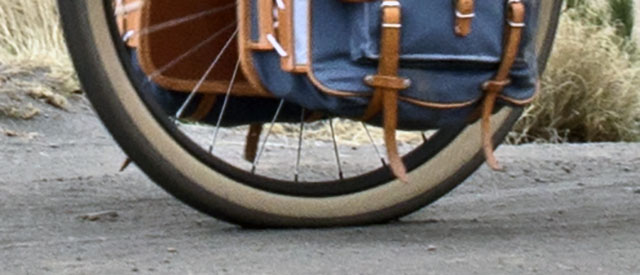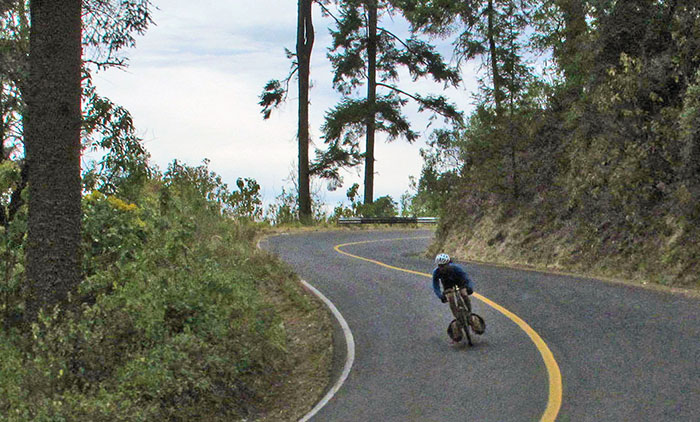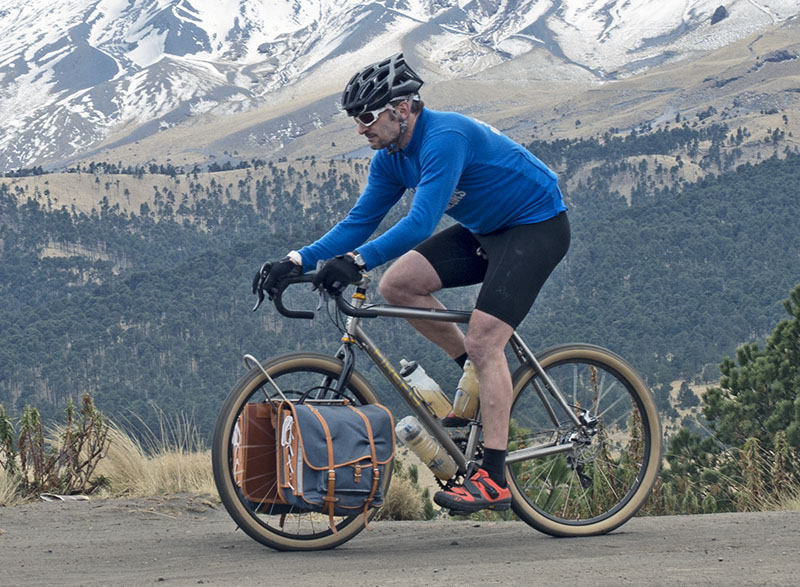Minimum Tire Pressure
Over the last few years, the idea that higher pressures don’t make your bike faster finally has become accepted. Many cyclists now run lower pressures to improve comfort and traction, without giving up anything in speed.
On gravel, lower pressures actually make you faster, since the bike bounces less. On soft gravel, like we encountered during our ride across the Paso de Cortés in Mexico (above), lower pressures (and wider tires) allow you to float on top of the surface, rather than sink in. Again, that makes you faster and more secure.
So lower pressure is better in many cases, but how low can you go?

Here is a detail from the photo on the Paso de Cortés. You can see how long that contact patch is – there is a lot of tire on the ground, which spreads the rider’s weight over a larger surface area.
Yet the pressure is not too low. The tire still holds its shape: Seen from the side, the tire sidewalls form a nice circle. That is the reason why it still rolls as fast as it did at higher pressures: The flex in the tire is limited to a relatively small area.
Only when viewed from above, can you see the contact patch bulge outward – but even that should not be excessive.

What happens if your tire pressure is too low?
- The tire can collapse when cornering. During our Mexican adventure, we pumped up our tires when we reached pavement, so we could tackle the fast and twisty descent with confidence (above). Even on gravel, a tire can collapse under the forces of cornering, if it’s not inflated high enough.
- You can pinch-flat, if the tire bottoms out, and the tube gets crushed between rim and road surface.

3. The tire can get damaged. When the tire gets kneaded too much with each revolution, it’s not only slower. (Yes, lower pressures do get slower at some point.) It also puts very high stresses on individual threads of the casing, which then can break. The tire needs a certain pressure to hold its shape and distribute the stresses uniformly over all the threads in the casing.
In the photo above, you can see a cross-hatched pattern where the casing threads have broken. This tire was tested by a magazine, and they rode these 35 mm tires at extremely low presssures of just 35 psi (2.4 bar).
The tire probably is still fine to ride, but if you try to run it tubeless, air (and sealant) will seep out of the tiny holes caused by the broken threads. (The sealant colored the sidewall where it leaked.) If you see a single zigzagging line in the tire sidewall where one thread has broken, increase your air pressure slightly to prevent further damage.
What is the minimum pressure that is OK to ride?
This depends on many factors, including:
- Rider weight. Obviously, heavier riders need to run higher pressures to prevent the tires from collapsing.
- Surface grip: The more grip you have, the higher are the forces generated during cornering. To withstand those forces, your tire needs to be inflated harder.
- Tire construction: A stiff tire is held up by its sidewalls as much as by the air pressure inside. A supple tire’s sidewalls do little to support the bike’s weight, so you need higher pressure. Thanks to the supple sidewalls, this tire still is more comfortable and faster, even at the higher pressure.
- Riding style: A rider who has a round spin can run lower pressures. If your bike starts to bob up and down with each pedal stroke, your tire pressure is too low. Fast riders need to run slightly higher pressures, since they hit obstacles with more force. And riders who corner on the limit need higher pressures to prevent the tire sidewalls from collapsing.
That’s why Rene Herse doesn’t list a minimum pressure for their tires – there is no technical reason to specify one, unlike the maximum pressure, which is dictated by safety considerations. Also remember that different pressure gauges can vary by up to 15%, so your 45 psi may be quite different from our 45 psi!
For the majority of riders today, the advice “When in doubt, let out some air!” still holds true, but as we lower our tire pressures, we need to be aware that too little air also can cause problems.
Photo credit: Cyclocross magazine (Photo 4)



